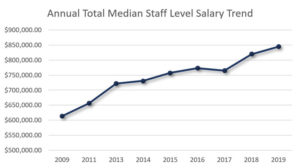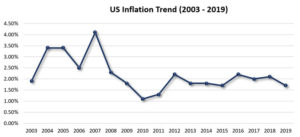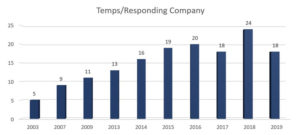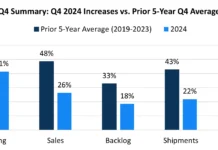by Ashley Turrell, membership & analytics director
MAPP
 Nearly two-thirds of all employees saw a salary increase above the current inflation rate of 1.7% in 2019. And overall, employees at plastics companies saw a compensation increase average of 3% across the board. However, the average compensation increase for jobs is down from last year (5% in 2018), according to the 2019 Wage and Salary Report, published in October by the Manufacturers Association for Plastics Processors (MAPP).
Nearly two-thirds of all employees saw a salary increase above the current inflation rate of 1.7% in 2019. And overall, employees at plastics companies saw a compensation increase average of 3% across the board. However, the average compensation increase for jobs is down from last year (5% in 2018), according to the 2019 Wage and Salary Report, published in October by the Manufacturers Association for Plastics Processors (MAPP).
The report, which analyzes compensation for 60 different positions in the plastics industry, now is in its 17th year. With input from more than 200 US plastics manufacturers, the data in the 2019 report represents approximately 47,500 full-time and part-time employees across 27 states.
 Just over 72% of plastics job titles experienced some growth in compensation in 2019. Twenty-five percent of positions analyzed in this year’s report revealed a greater than 5% growth in wage/salary, down from 50% in the 2018 report. Compensation for only 5% of job titles rose 10% or more.
Just over 72% of plastics job titles experienced some growth in compensation in 2019. Twenty-five percent of positions analyzed in this year’s report revealed a greater than 5% growth in wage/salary, down from 50% in the 2018 report. Compensation for only 5% of job titles rose 10% or more.
$845,000 represents the total median annual compensation for a combined nine staff-level positions that are considered the most common staff-level positions occupied in companies (up from $819,312 in 2018). Staffing critical positions continues to be a top priority for manufacturers, and many of those critical roles saw significant increases in overall pay in 2019 as a reflection of that need. Overall, engineering and production-related job functions saw the highest average increase over any other major department in the industry.
The increasing costs of compensated employees, low unemployment, economic uncertainties and the push for automation may be why the number of companies looking to hire new employees decreased nearly 10% from last year. In 2019, 86% of organizations reported a desire to hire over the next 12 months; however, companies are not looking to hire in large numbers. Over 60% of those organizations that are actively looking to hire new employees are looking to hire fewer than 10 new individuals. In 2018, manufacturers reported looking to hire in record-high numbers; however, in 2019, the number of new hires dropped almost 25%.
 Additionally, employee turnover rates continue to climb at plastics companies. Average turnover rose from 17% in 2017 and 21% in 2018 to 27% in 2019. High turnover has many plastics companies utilizing temporary staff to fill current demands. Thirty-six percent of participants indicated that their company does use temporary help to fill gaps in staffing. In 2003, companies that utilized temporary help had, on average, approximately five temporary help workers in their facilities. Today, that number has nearly quadrupled, with respondents noting their companies have an average of 18 temporary help workers.
Additionally, employee turnover rates continue to climb at plastics companies. Average turnover rose from 17% in 2017 and 21% in 2018 to 27% in 2019. High turnover has many plastics companies utilizing temporary staff to fill current demands. Thirty-six percent of participants indicated that their company does use temporary help to fill gaps in staffing. In 2003, companies that utilized temporary help had, on average, approximately five temporary help workers in their facilities. Today, that number has nearly quadrupled, with respondents noting their companies have an average of 18 temporary help workers.
Trying to hire and retain employees in the market has led to changes in how compensation increases are determined. For instance, from 2011 to 2014, only about half of plastics companies decided to award pay increases on a merit-based/performance-based system. Today, 78% of plastics organizations report granting salary increases based on performance or merit. Utilizing a performance-based pay increase has become more attractive to manufacturing organizations, as the potential for increased pay is thought to increase employee retention and overall productivity. However, a smaller percentage of organizations continue to grant across-the-board increases, cost-of-living adjustments and length-of-service salary increases.
No matter how compensation is determined, it is clear that manufacturers need to be regularly analyzing their pay structures. Companies need to make compensation decisions based on data rather than gut feel, and a key component in that is knowing how they compare to their counterparts when recruiting and retaining employees.
More information: www.mappinc.com




